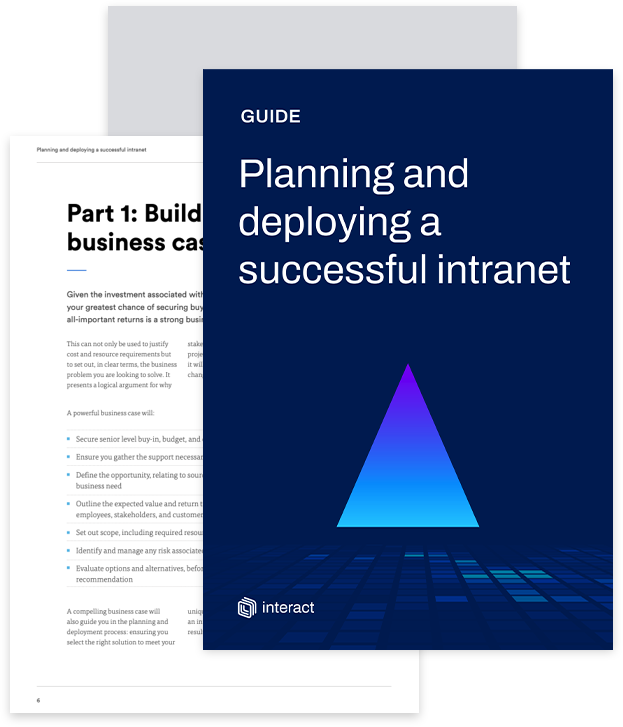Why are we doing this? Defining your intranet purpose and objectives

Planning and deploying an intranet takes time, effort and a good strategy. So how do you know you’re defining your intranet purpose?
Any company looking at implementing an intranet should first consider what exactly it is they are looking to get out of their investment. All successful intranet projects start with careful planning and mapping out of the changes you want to see within your organization.
Start mapping out your intranet purpose and objectives by reading our essential guide.
Your company’s intranet should be valued as one of your most important assets. With this in mind, addressing your business objectives will be significant in the success of your overall internal communications. In turn, this will influence critical workplace components such as engagement, collaboration and sharing of information between your employees.
To what extent will the introduction of your intranet impact your employees? Here are the essential initial steps to follow to best-provide for your workforce:
- Educate yourself on all of the ways in which your intranet will drive employee engagement
- Question how an intranet will support your employees
- In what ways can we ensure employees are knowledgeable enough to confidently use the intranet on a daily basis?
Why do I need an intranet strategy?

Like any new project, prior to setting up your intranet, you should come prepared with a high-level understanding as to what exactly you are striving to achieve. Alongside gathering ideas prior to setup, the strategy must be in place post-implementation to ensure you are measuring the fulfillment of your intranet’s potential.
Here is a list of intranet benefits which you can measure your success to:
- Improves internal communication
The ultimate component in measuring intranet success – your business communication has noticeably strengthened, and your organization has seen employees conversing and actively working together for multiple reasons. - Easily helps employees locate information
Sharing information becomes much easier when a central hub is in place for employees to access various materials. This will not only reinforce clarity and connectivity but save individuals’ time getting hold of information. - Engages personnel of all roles and levels of seniority
Facilitating management and grassroots staff is essential for collaboration. Often the fear factor of approaching senior members of staff and managers not recognizing individuals can reduce the relationship potential between workers. - Reinforces your brand and values
Not only does an intranet provide great benefits internally for your organization, but it also has a positive impact from an external perspective. Customers, competitors, and interested applicants will hear about your brand through the cultural values which are internally driven. - Connects your company across locations and time zones
For global organizations, the ability to share information and coordinate between offices of different regions is fundamental. Social tools support this functionality, meaning employees of all offices remain updated with the ins and outs and generally feel part of the bigger picture. - Encourages ideation and supports knowledge sharing
Social hubs prevent employees from becoming fragmented figures within companies. Knowledge sharing stimulates workers to take part in collective ideation, leading to greater levels of collaboration, social activity, and project building skills. - Amplifies company culture
Introducing a platform where employees are enabled to broadcast company success, transfer confidence through social engagement and inspire one another through ideation results in an enhanced company culture. - Ensuring the intranet is accessible to and used by all employees
Refraining your workforce from becoming siloed members of your intranet is pivotal to fulfill user happiness and engagement. No matter the job role, department or level of seniority, every member of your organization should be accounted for in order to maintain a well-rounded and transparent company culture.
Start mapping out your intranet purpose and objectives by reading our essential guide.
Interact’s own, Louise Berry similarly discusses intranet benefits in the following blog.
What happens if I decide against following a strategy?

Choosing to go it alone, in any project, greatens the chances of failure. An intranet’s success is dependent on clarifying its potential and having a well-documented plan of guidelines to follow. Stepping into the deep end without a plan in place increases the chance of disgruntled employees, lower return on investment, and stalls your organization’s work efficiencies elsewhere.
Put simply, your business goals are far less likely to be achieved, or at the very least, achieved at a much slower pace. This is when your investment starts becoming questionable and your boss begins casting doubt over your decision to acquire an intranet.
Below is a list of typical reasons which can lead to an intranet failing:
- Lack of staff engagement and/or interest
- Little support from management and senior staff
- Not fully educating employees on how to use the intranet
- Slow performance
- Poor file sharing options
Constructing your intranet strategy

When putting together any strategy, taking small steps is always the best policy for returning optimum results.
Begin by assessing your organization’s current situation and asking yourself what has brought you to the point of considering investing in an intranet. In what ways do you want to help your employees and how can an intranet provide these solutions for you?
| Stage | Considerations | What to do next | Objectives/Goals |
| Put your workforce first | Purpose of intranet for employee support | Analyze the current condition of your employee’s internal comms | A clear understanding of your employees’ needs and challenges |
| Conduct interviews | The solutions you look to deliver against your employees’ challenges | Assemble your relevant colleagues to help form the questions you want to ask your workforce | Obtaining clear and informative feedback |
| Possible solutions | Assess and categorize most significant solutions | Build a plan of how to go about solutions | Have a list of realistic solutions which are ready for implementation |
- Put your workforce first
True of any organization looking to improve internal communications, employees are the main focus point. The primary users of your intranet must be at the center of your plan or else failure is inevitable.
Ensuring you are putting your employees first requires you to ask critical questions of your organization. This will help uncover exactly how well your company is operating and will provide a stepping stone for the next steps in managing your challenges.
Ask yourself in what ways will your intranet be supporting your employees, and how will this impact the ways in which they use it? Measure the extent to which your intranet involves your staff and how successfully is information shared around the organization.
Recognize the challenges and limitations of your existing intranet, if you have one, drilling down on particular features which require fixes and improvement to enable maximum efficiency for your workforce. - Conduct interviews
To help the decision-making process, get as many of your employees involved as possible to answer questions regarding your intranet’s performance.
Gather feedback from your employees on how well your intranet operates for them on a personal level. Knowing what each individual thinks of your software will provide you with a far more transparent understanding of what is working well and what is failing.
Intranet objectives and standards could include:
– Enhancement of information and resource searchability
– Content and document management
– Ease of navigating across the intranet
– Mobile-friendliness
– Improving engagement levels for employees
– Page speed and general site efficiency
– Project collaboration and task management coordination
– Reducing time spent managing remote employees
– Providing proficient management of calendars, events, and meetings
– Notification tabs are working correctly, and are informative and responsive - Consider, suggest, and execute possible solutions
Now you have feedback from your employees, give particular attention to the components of your existing intranet or internal comms solution which are failing.
You may find you have an overwhelming number of features that your employees have listed as issues. Filtering through which of your issues are a priority for improvement is essential moving forward.
This process will require you to assemble a team who will be responsible for implementing your intranet. Decisions over such operations are rarely made by one person alone; it is, therefore, essential you are equipped with an efficient team who share roles within your intranet management.
In order to best carry out this procedure, ensure you follow the below steps:
- Establish who is responsible for work assignments in this project
- Recognize who the final decision maker is and at what point to consult them
- Understand who needs to be kept informed when a decision has been made
Meticulously ticking off each of the above steps will ensure time and spend are kept at a minimum, while greatening the chances of making your intranet a speedy success.
Once you have launched your intranet, underpinned by this considered strategy, the work doesn’t stop there. It is necessary to undertake continual performance analysis, whilst staying adaptable towards your strategy to ensure the intranet continues to meet your objectives. Strategy is organic: your organization will grow and change, so your intranet needs to grow and change too.

